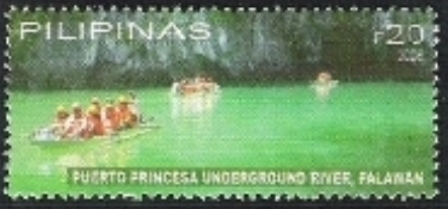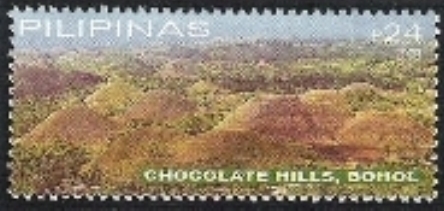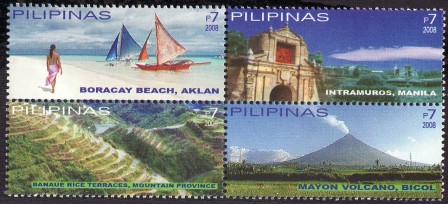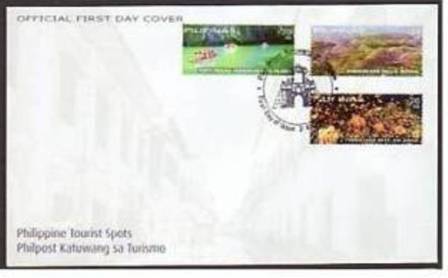2008, November 3. Philippine Postal Service, 110th Anniversary
Featuring Various Tourist Spots
Se-tenant Blocks of 4 (7p x 4); Singles (20p, 24p, 26p); Sheets of 40 (4 x 10)




Se-tenant Blocks of Four (125,000)
7p Boracay Beach, Aklan
7p Intramuros, Manila
7p Banaue Rice Terraces, Mountain Province
7p Mayon Volcano, Bicol
20p Underground Reef, Puerto Princesa - Singles (125,000)
24p Chocolate Hills, Bohol - Singles (125,000)
26p Tuddataila Reef, Palawan - Singles (125,000)
First Day Covers: Manila

PHILIPPINE POSTAL SERVICE - 110th ANNIVERSARY - FEATURING TOURISM
The tropical island of Boracay, in north Aklan Province, is one of the Philippines' most popular destinations. Its white sand beaches are the island's main draws. Choose from Yapak Beach, with its white shells, White Beach, with its amazing sunsets, and romantic, secluded Balinghai Beach. Off the sands, good restaurants, enticing shopping and Boracay Butterfly Garden provide other appealing diversions. Explore the 4.5-mile-long island by motorized pedicab or rent a bicycle or motorbike from your resort.
Walking Tour through Intramuros. Right in the heart of Manila is found the "Walled City" - Intramuros. Constructed in 1571, during the period of Spain's colonization of the Philippines, it comprised of European buildings and churches that have been replicated in different parts of the archipelago. Although the Pacific War of the 1940s took its toll on Intramuros, it had been one of the world's best preserved medieval cities. The site is a timeless journey through forts and dungeons, old churches, colonial houses, and horse-drawn carriages. Intramuros, located along the southern bank of the Pasig River, was built by the Spaniards in the 16th century and is the oldest district of the city of Manila, the capital of the Philippines. Its name, in Spanish, intramuros, literally "within the walls", meaning within the wall enclosure of the city/fortress, also describes its structure as it is surrounded by thick, high walls and moats. During the Spanish colonial period, Intramuros was considered Manila itself.
Banaue rice terraces has been described as the eighth wonder of the world. Carved out of the hillside by Ifugao tribe’s people 2000 to 3000 years ago without the aid of machinery to provide level steps where the natives plant rice. And they are still in use today. In 1995, they were declared a UNESCO World Heritage Site. Banaue rice terraces stretch like stepping stones to the sky - some reaching an altitude of 1500m (4920ft). It is considered as one of mankind's greatest engineering feat. If the terraces were laid end to end, they would stretch half way around the world. http://www.philsite.net/banaue.htm
Mayon Volcano reaches 2,460 meters and is the central feature of the Albay Province, of which Legazpi City is the capital, about 300-km southeast of Manila (View Map). It must be one of the most beautiful volcanic cones anywhere in the world and is visible for miles around in the otherwise flat landscape of the region. The volcano is still active and has erupted in 2000 and 2001. There is a research station (PHIVOLCS) located about one-third of the way up that is accessible by road and is the jump-off for climbers. See also Climbing Mayon Volcano and other Bicol Region Tourist Destinations. Here are six photos I took from several locations around the volcano. http://www.aenet.org/volcano/mayon.htm
The Chocolate Hills are probably Bohol's most famous tourist attraction. They look like giant mole hills, or as some say, women's breasts, and remind us of the hills in a small child's drawing. Most people who first see pictures of this landscape can hardly believe that these hills are not a man-made artifact. However, this idea is quickly abandoned, as the effort would surely surpass the construction of the pyramids in Egypt. The chocolate hills consist of are no less than 1268 hills (some claim this to be the exact number). They are very uniform in shape and mostly between 30 and 50 meters high. They are covered with grass, which, at the end of the dry season, turns chocolate brown. From this color, the hills derive their name. At other times, the hills are green, and the association may be a bit difficult to make. http://www.bohol.ph/article6.html
-
Tourism
-
Boats / Ships
-
Churches
-
Volcanoes